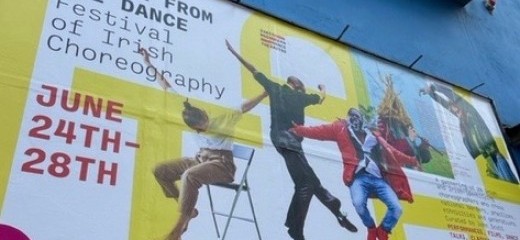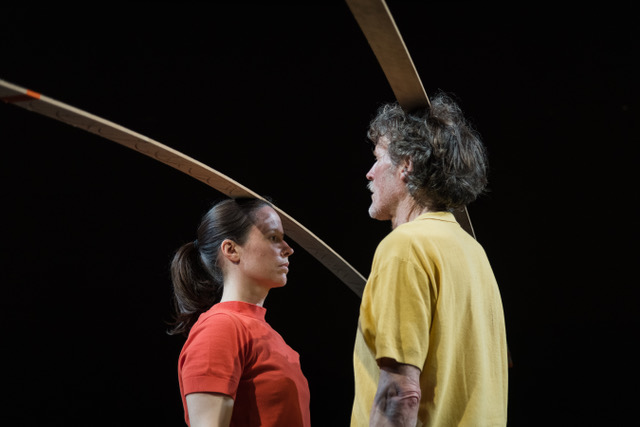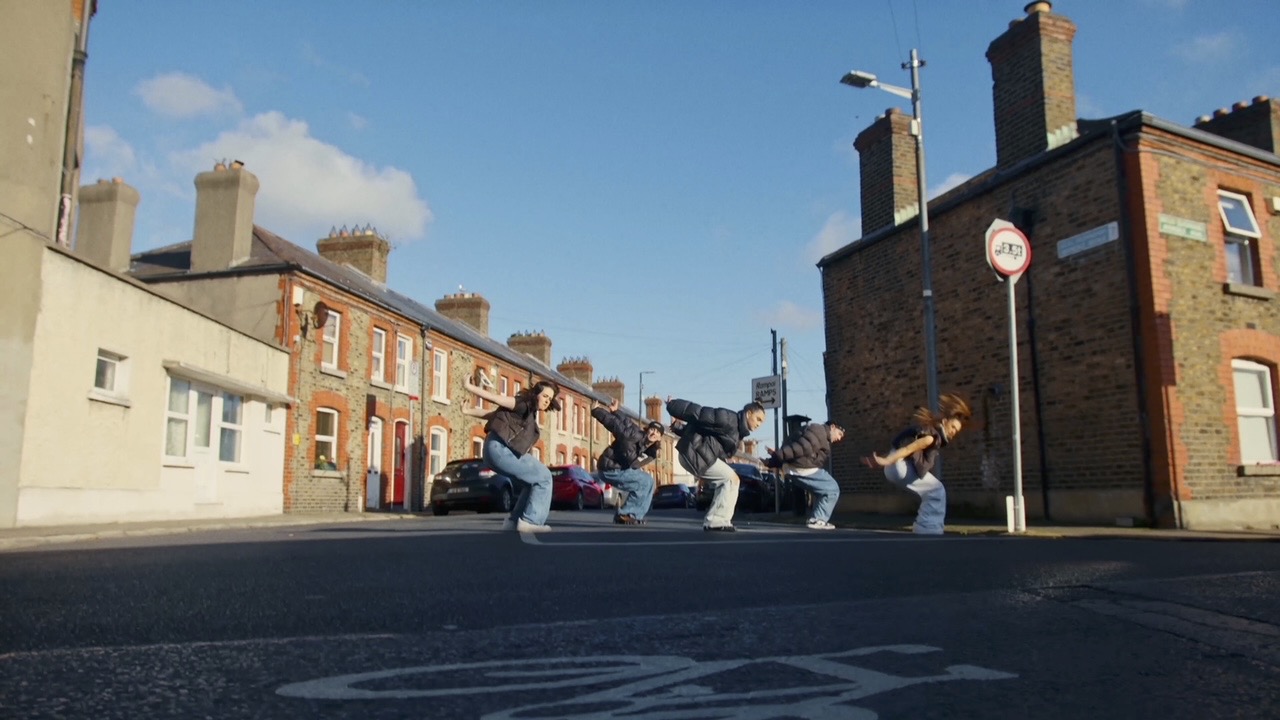
IMDT's Irish Dance Festival: 28 Artists in 5 Days
by Terry Fox
Choreographer, performing artist, and Director of the Irish Modern Dance Theatre, John Scott is Curator of the Dancer From The Dance, Festival of Irish Choreography. This festival, recently presented in Dublin, was “a gathering of Irish and Irish-identifying dance and movement artists who cross national borders, practices, ethnicities, and generations.”
Scott brought together twenty-eight artists for 5 days of live performances, films, workshops/classes, and a panel discussion. I experienced the inclusive mix of dance creativity ongoing in Ireland today, an engrossing representation of imagination and productivity drawing on a wide swath of global dance styles and traditions, as well as reflections on traditions that are more particularly Irish. It felt free, open, and not limited to themes or esthetics.
Festival events took place in two small venues, Project Arts Centre and the Irish Film Institute in the center of Dublin. Spotlighted were many accomplished individual artists performing solos or duets, using many different style vocabularies entwined with a wide range of content. I’d like to mention a few.

Bád Shiobhán (Siobhán’s Boat) with dancers Shiobhán Ní Dhuinnuín and Pádraig Ó Duinnin. Photo: Jed Niezgoda
Bád Shiobhán (Siobhán’s Boat) by Shiobhán Ní Dhuinnuín, performed by her with Pádraig Ó Duinnin, was one of the most tender and unassuming dance works I have seen in a very long time. The stage is set with a sheet of plywood resting on two sawhorses and, elsewhere, a piece of canvas. Two dancers enter carrying long, flat strips of flexible wood that resemble aerial balancing poles. They converse and sing in Gaelic and playfully spar like parent and child. A short video projected on the plywood, reveals that the long strips of woods are used to make a boat. The performers’ easy, charming relationship and their relationship to the materials for building a boat become all absorbing. At the finish another video appeared of a boat being rowed across a body of water. Hearing only the sound of the oars tapping the sides of the boat and the lapping of water, I was transported to another time and place. I sensed a deep connection to that natural geography and how humans have lived and moved through it with mutual grace and kinship.
O Dabò, a solo by Nigerian Irish multidisciplinary artist Favour Odusola, uses a soundtrack of his mother singing. His dance is interrupted by a cell phone ring and message that we do not hear, but can only assume from his dramatic reaction of shock that it is terrible news (a death perhaps—as per the program notes, “one final goodbye conversation.”) His dance ends with him drumming—his body extending his feelings into sound that reverberates throughout the small theater.
A Dance, a solo performed by Polish émigré Magdalena Hylak, accompanied by composer of electronic sound Lionel Kasparian, reveals a dancer who is a relentless experimenter of repetitive movements that concentrate on her arms, head, and full body twisting, and then on the floor pushing. The momentum of gestures and sound build to almost extreme levels. The net effect produces an altered perception; the eyes see multiple images of gestures, and the ears push the pulse into the body. There is a virtuosity in her mesmerizing exploration.
Two solos to piano music that appeared back to back on the same program, which oddly matched each other, were Mar Do Thinteán Féin—performed by Gearóid Solan—and Impromtu by Steve Batts. Solan is a young ballet dancer, and Batts a post/modern dancer of forty years. It was a pleasure to see these two dancers in contrast. Confident, with impressive ballet chops, Solan performed to a playful, almost cheeky rendition of “O Danny Boy,” that morphed into “My Irish Molly” without skipping a beat of showoff balletic male bravado. In Steve Batts’ Impromptu—A Dance With Shubert’s impromptu in G Flat Major, Played By Radu Lupu, in a path from upstage to downstage his upper body flowed, with arms and hands gesturing to the exquisite gurgling music and the melody’s crescendo or decrescendo, into a delicate stop.
Two other short solos that appeared on another program interested me in their use of hip hop. What If? performed by Alex O’Neill to his own personal existential text and original use of locking and popping, while Cristian Emmauel Dirocie, émigré from the Dominican Republic, performed Breaking. He masterfully danced in silence, wearing a pink shirt and baggy rose-colored pants that rustled with all his moves. Only hearing the moving dancer more acutely revealed an inner spirit at work. The two artists demonstrated, in an affirming way, how the interplay of influences and styles is being traversed by contemporary dance artists in Ireland with a very open and free acceptance.
Two Mummers, dancer Edwina Guckian and concertina player Aaron Glancy, performed “Knockin’ Sparks.” The dancer wore the Irish mummer’s headdress of straw that covers the entire head and rests on the shoulders, an ancestral tradition in County Leitrim. Her footwork was fancy, complicated, and smart—his bright rhythmic music was spirit-lifting. After performing “she talked about learning from her grandfather by following him along with the other mummers as they went from house to house. She said they danced on the hearthstone, where a horse’s skull buried beneath produced a resonant sound and, when the stone heated up, caused sparks to fly from the dancer’s feet. Now keeping this ancient tradition, she has taught hundreds of students, including the musician accompanying her.
The Dancer from the Dance festival also featured dance films screened at the Irish Film Institute. Two films stood out to me as they grappled with home and issues of living in urban Dublin today.

Oscillation with dancers Adam O'Reilly, Amy Whearity, Isabella Care, Kian Swift and Caitlin Rooney. Photo: Andrew Ascough
In Oscillation, directed by Adam O’Reilly, a diverse group of young people dance in neighborhood streets and on the strand. The singer raps, “My name, you can’t Google it…" With a sense of defiance to their anonymity, they assert their presence with dances of joy and ebullience. In Golden Thread, directed by Eoin Heaney and performed by Sebastião Kamalandua, a lone figure moves through vacant, darkened streets with a sense of tenuous connection to staying alive. Buildings are kicked. It ends abruptly, and the viewer is left with no understanding of the dancer’s fate.
The Dancer From The Dance festival is an inspiring confluent ground of many traditions on which community is being built by Irish dance artists. It indicates that being generous in exchanging and appreciating customs and styles and sharing resources helps everyone flourish. It demonstrates that art can lead the way as an example for mending (or at least living better together in) a more fractious world at large. It is particularly exciting that dance can be this model.
Dancer From The Dance, Festival of Irish Choreography, Presented by Irish Modern Dance Theatre, June 24-28, 2023, Dublin, Ireland
By Terry Fox
August 14, 2023






